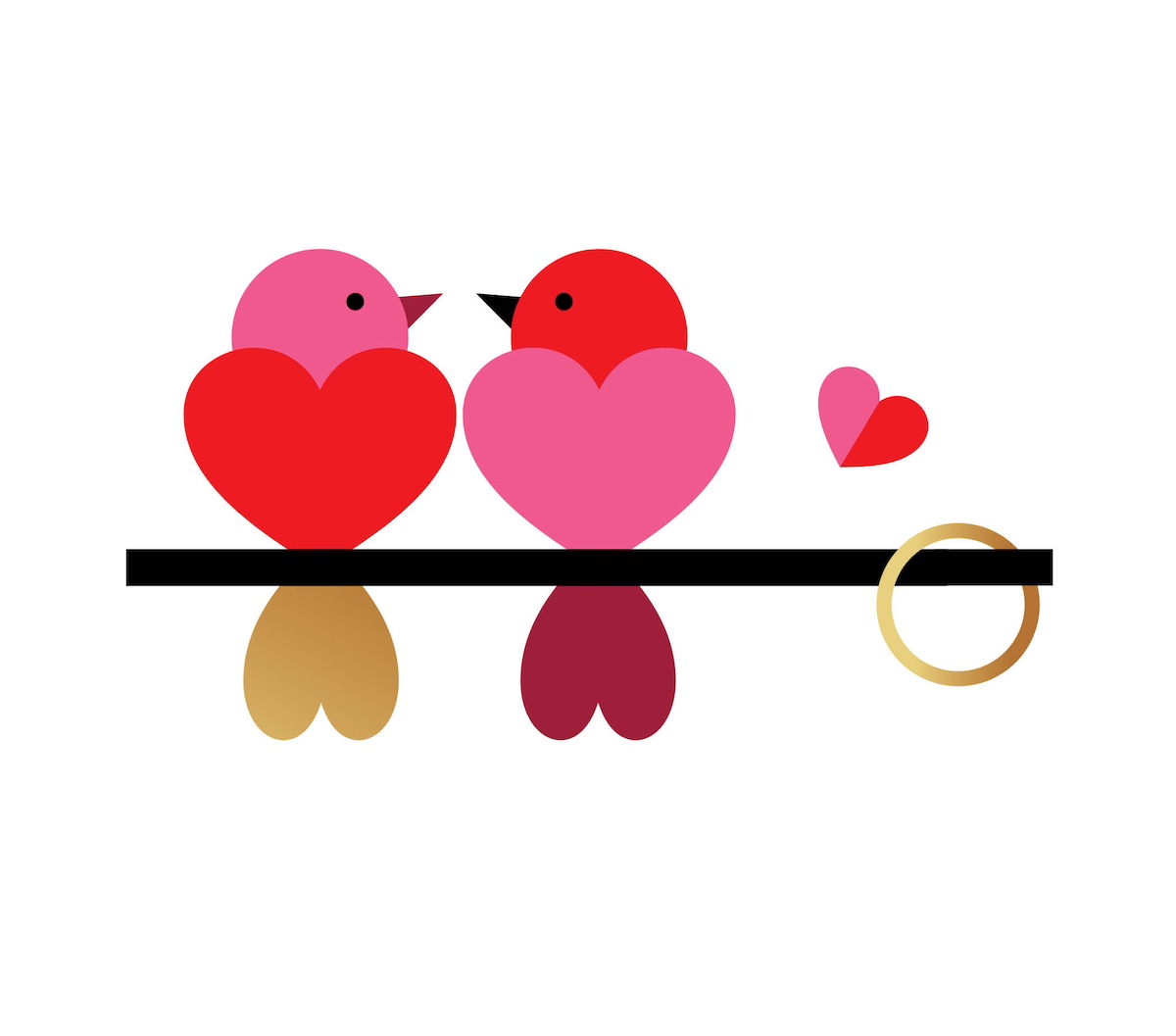With pink and red hearts and Cupids everywhere you look, it’s hard to ignore that this is the month of love. Not only do many celebrate Valentine’s Day, but it’s also the last month of engagement season — when more people pop the question than any other time of the year.
But people are not saying “I do” to the same things that our parents, grandparents and great-great grandparents said “I do” to. Marriage was a financial arrangement (and still in many ways is). Most were arranged based on what political positioning or power the union would bring, often foisted on women as a way for men to get their agendas — political, social, fiscal or sexual— satisfied (never mind what the women wanted).
Along the way, marriage, at least in the West, twisted and turned into various iterations — from a financial contract, to a companionate model, until it eventually landed where we are today, a soul mate model built on romantic love. Love in marriage used to be considered ridiculous, immoral and even dangerous, posing a threat to other important relationships, such as with one’s parents or with God.
Yet love is the reason most people tie the knot, which, as marriage historian Stephanie Coontz describes in her 2006 book, Marriage, a History: How Love Conquered Marriage, has made the whole institution unstable.
In other parts of the world, marriage has and continues to look different. Polygamy, polyandry and polyamory have been common and in some places still are; for some Cantonese people in China, daughters may marry a dead person; marriage could be temporary in some pre-Islamic societies; and for the Vanatinai people near Papua, New Guinea, a relationship becomes formalized when a couple starts eating together.
So much for the idea of “traditional” marriage or the Cinderella version most of us have bought into.
Paradigm Shift
Fewer young people are marrying and those who are tying the knot are increasingly marrying later. More people are marrying multiple times and fewer are having children. Some are single parents by choice or co-parent with a non-romantic partner. The “traditional” nuclear family, a relatively recent concept, is no longer the dominant family form, according to the Pew Research Center.
Singles make up about 48 percent of the county’s population and some are no doubt among the growing numbers of people who are quite happily single and not necessarily even interested in dating.
At 58, supermodel Linda Evangelista recently told The Sunday Times that she has no interest in dating because “I don’t want to hear somebody breathing.” Keturah Kendrick, author of the 2019 book No Thanks: Black, Female, and Living in the Martyr-Free Zone, declares that she’s “meant to be an unmarried Black woman, absent of children, living a joy-filled, fulfilling life” and encourages other Black women to do the same on her podcast, “Unchained, Unbothered.” Actor Sharon Stone declared when she was 62 that she was done with dating. Same with actor Teri Hatcher, who told People, “Many women are not just surviving alone, they’re thriving. They’re empowered, they’re making money, they’re being healthy, they’re traveling. You are allowed to be proud of your life when you’re not part of a couple.”
Bella DePaulo, a Harvard-trained social psychologist and singles expert who started a Facebook page, Community of Single People, with nearly 8,000 members, calls them “single at heart,” the title of her just-released book. That includes people who have never married or lived with a romantic partner, to people who have, sometimes several times, to people who are still interested in dating. What they all have in common is that they don’t put a romantic partner at the center of their lives, and don’t want to organize their lives around a romantic partner.
“For us, single life is our best life. It is our most authentic, meaningful, and fulfilling life,” writes DePaulo, who’ll be at Book Passage in San Francisco on Feb. 13. “To us, living single is every bit as normal, natural, comfortable, and desirable as a committed romantic partnership is to people who are drawn to coupled life.”
NPR producer and editor Rhaina Cohen’s book, The Other Significant Others: Reimagining Life with Friendship at the Center, which is out this month, makes a case for making friendship, not marriage, the center of our life, and questions the idea that “a long-term monogamous romantic relationship is necessary for a normal, successful adulthood.”
Gen Z already seems to be all in. According to UCLA’s Center for Scholars and Storytellers annual survey, more than half of youths aged 13 to 24 want to see more TV shows and movies centering friendships and platonic relationships instead of romantic relationships.
They aren’t the only ones. Some 61% of U.S. adults say having close friends is extremely or very important for people to live a fulfilling life, according to a recent Pew Research Center survey —far more than those who say the same about being married or having children.
Although marriage rates are down across the country and globe, Marin is still a very coupled county. But not all of those couples are married — some have been living together for decades and have raised children without ever putting a ring on it. And others, married or not, don’t share a roof.
Choose Your Tribe: Community is Key to Fulfillment

About three years ago, a friend forwarded an email to Veronica Napoles. Casting agents were looking for single women 60 and older for a version of The Bachelor for seniors. “Go for it!” her friend said.
A newly minted 70-year-old at the time, Napoles, who has been divorced for almost two decades and with a few romantic relationships behind her, thought, why not?
It was of course for The Golden Bachelor, the latest spinoff of The Bachelor franchise and the first time the reality TV show featured women in their 60s and 70s vying for the love and attention of a senior bachelor, Gerry Turner, a 72-year-old retired widower, father and grandfather, that aired last fall.
After making it a few rounds into the casting process, Napoles, who splits her time between Marin and Sonoma, changed her mind. And once she found out who the “golden bachelor” was and where he lived, Indiana, she knew she’d made the right decision.
“I’ve been here for 48 years. This is where I have all of my tribe,” she says.
But beyond that, Napoles has lost interest in looking for love. Her family and friends as well as her art and work as founder of the nonprofit Wake Up Sonoma, a grassroots citizen’s watchdog organization, keep her busy and, more important, fulfilled.
She’s among the many people in Marin who have discovered that happily ever after doesn’t always look like the fairytales we’ve been brought up with, and who are helping to change the landscape of relationships in the 21st century.
Live Apart Together (Lat) Can Mean Different States or Across the Street
Cheryl (she prefers to use her first name) is one of them. The 60-something divorced mom of three adult children has been with her romantic partner, a divorced dad of three, for about three and a half years. She lives in Southern Marin, he lives in Arizona, and they see each other about 10 days a month.
They didn’t plan to have what’s called a live apart together (LAT) relationship, but that’s what they stumbled into and it’s working great. They have the best of a loving committed relationship and the freedom of single life.
“I have a really full life. I have lots of friends here. I’ve lived here a long time. I love my job. I live in a beautiful neighborhood. I really like my life,” she says. “ I love being with him, yet I also really enjoy my time away. I find it is a really good balance. I have time to spend with my friends and focus on work and not feel bad that I am not home. When he is visiting, then I can focus on our time together.”
The LAT lifestyle seems to be a good fit with people who, like Cheryl, are in later-in-life relationships. At that age, many people have lived in their homes for a long time and may have little to no mortgage. They’re often deeply connected to their community and may have adult children and grandchildren living nearby. There’s little desire to uproot their life to cohabit with a new romantic partner or buy a home together, especially when the median price of single-family homes in Marin are way over $1 million and mortgage rates are high.
But it’s also attractive to people who have children from previous romantic relationships and don’t want to re-create something akin to The Brady Bunch.
Louise (not her real name) doesn’t have to hop on a plane to see her romantic partner of nearly four years — she lives across the street in Novato from him and his young daughter.
After a traditional marriage in which she lived with her husband, Louise says having a home of her own really matters to her. It’s a place to retreat to after spending time with her boyfriend’s daughter — on her terms. Plus, it’s clean and quiet, she says with a laugh.
Mary Chase, a writer and media producer in her late 70s, is also in LAT relationship. But rather than cohabit with her boyfriend of 16 years, who lives off the grid on the Central Coast, Chase rents a house in Novato with three other women, all aged 50 and older — their version of The Golden Girls.
Their house is modeled after the communal community house Chase lived in for 18 years that sold last summer. She and Lindy Woodard, another member of Cabro Community and both divorced after long marriages, decided to re-create it, but on a smaller scale. It’s a way to afford living in Marin as senior women, they say, but it’s more than that.
“I was interested in community since I was a young person. It never made sense to me that we all had our own washing machines,” says Woodard, also in her 70s and a part-time practicing pediatrician in Mill Valley. “Always for me, it was important for the environment, for use of resources. But then when I really started doing it, I really loved the camaraderie.”
Communal living’s not for everyone, Chase says. Still, loneliness has been called an epidemic by Surgeon General Dr. Vivek Murthy. With Marin having the largest population of people in their 60s and older, who often live alone, in the Bay Area, that is particularly important.
“At the heart, I think people would like to have more community in their lives,” Chase says. “Being able to be in relationships with others is so important as you age. It’s actually, I think, the most important thing.”
With no need to put a ring on it.
Vicki Larson is a longtime award-winning journalist and author of Not Too Old for That: How Women are Changing the Story of Aging, named a Best Book of 2022 by Take the Lead; co-author of The New I Do: Reshaping Marriage for Skeptics, Realists and Rebels, named a Best Book of 2014 by PopSugar; and the forthcoming book LATitude: How You Can Make a Live Apart Together Relationship Work (July 2024). She’s called Marin home for nearly four decades.


